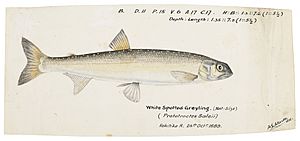New Zealand grayling facts for kids
The New Zealand grayling (Prototroctes oxyrhynchus), also known as upokororo or pokororo in Māori, was a type of smelt fish. It lived only in the rivers and streams of New Zealand. These fish were special because they were amphidromous. This means they would lay their eggs in freshwater streams, but then grow up and live most of their adult lives in saltwater, like the ocean.
Quick facts for kids New Zealand grayling |
|
|---|---|
 |
|
| Conservation status | |
| Scientific classification | |
| Genus: |
Prototroctes
|
| Species: |
oxyrhynchus
|
Even though there were many New Zealand grayling when European settlers first arrived, their numbers started to drop by the 1870s. The very last one known was caught sometime between the late 1920s and early 1930s. Sadly, this fish is now extinct.
Scientists believe several things led to their disappearance. Cutting down forests (deforestation) changed their river homes. Also, new fish like trout were brought to New Zealand. These trout might have eaten the grayling, competed with them for food, or spread diseases. For example, a similar fish in Australia, the Australian grayling, also suffered greatly from diseases after trout were introduced there.
Years after the last grayling was seen, in 1951, the New Zealand government gave the species full legal protection. It was the only native freshwater fish in New Zealand to get this special protection. In August 2018, the New Zealand Department of Conservation officially listed the New Zealand grayling as "Extinct."
What the New Zealand Grayling Looked Like
The New Zealand grayling usually grew to be about 30 to 45 centimeters long. They had a slim body shape. They also had a small, fleshy fin on their back called an adipose fin.
When these fish traveled between freshwater and saltwater, their color would change. They were usually silver. But when they moved, they could turn darker, becoming grey or brown, and sometimes even golden. Their belly, however, always stayed light in color.
Images for kids
See also
 In Spanish: Prototroctes oxyrhynchus para niños
In Spanish: Prototroctes oxyrhynchus para niños




